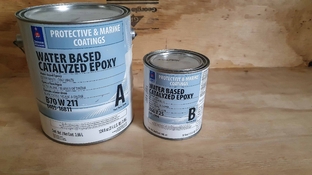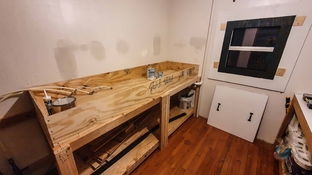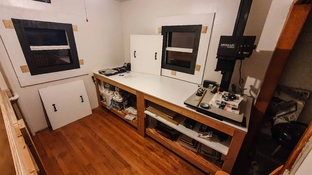I have completed two major tasks in getting my darkroom functional again. I've finished the window blackout/portals and I have built another sink. My question is regarding the epoxy paint that I used several years ago...............I still have some and I'm wondering if anyone thinks the epoxy components A&B would still work together as they are expected to given the fact that it is pretty far past it's shelf life. I took it to Sherwin Williams today and had them give the cans a good shake. By all appearances it still looks good and has good consistency and the attendant wasn't sure of this question so I am putting it to folks here that may have more experience with these type products. Thank you.
You are using an out of date browser. It may not display this or other websites correctly.
You should upgrade or use an alternative browser.
You should upgrade or use an alternative browser.
Out of shelf life ----Water Based Catalyzed Epoxy Parts A & B
-
A
- Thread starter Chuck_P
- Start date
Recent Classifieds
-
For Sale New 55 instant film (replacement for polaroid type 55)
- Started by Early Riser
-
Free 16x20 and 20x24 expired Ilford multigrade paper, Portland Oregon pick up
- Started by Early Riser
-
For Sale Helipan 112mm Circular Polarizer
- Started by Early Riser
-
Sold For Sale: 10 rolls of 120 film *SOLD*
- Started by Brad Bireley
-
Free Free; Bright Lab Jr. Safelight for Shpg Cost
- Started by waynecrider
Forum statistics
If the cans were pretty much full, you are probably OK. If they are half used up, I'd trash them. But it's easy to test. Try it on a scrap piece of wood and see how it gels.
I can't recall how many layers I put on my sink -- that was so long ago.
I can't recall how many layers I put on my sink -- that was so long ago.
If the cans were pretty much full, you are probably OK. If they are half used up, I'd trash them. But it's easy to test. Try it on a scrap piece of wood and see how it gels.
I can't recall how many layers I put on my sink -- that was so long ago.
Part A had 3/4 of a gallon and Part B was minus just 6 or 8 ounces that was used to satisfy the 4:1 mix ratio. I used a quart mixture the first go round.
As always recommended with paints in general: give it a try on a small section hidden mostly out of view, let dry and evaluate the result.
My bets are if both cans are still free-flowing liquids the whole thing should work just fine.
My bets are if both cans are still free-flowing liquids the whole thing should work just fine.
Rick A
Subscriber
If the paint and catalyst are in separate containers (unmixed) then they should be good to use. Mix a test batch and check it out.
Rick A
Subscriber
Well I made a small test batch and painted a scrap piece of wood...............it looks good, just not sure how to know if it's epoxy properties are maintained or not.
How long did it take to dry/cure? Wait a day and try to scratch it, check for durability. Other than that, you'll just have to trust it, worst that can happen is you need to buy new and recoat.
How long did it take to dry/cure? Wait a day and try to scratch it, check for durability. Other than that, you'll just have to trust it, worst that can happen is you need to buy new and recoat.
After a little more than an hour it was dry to the touch, there's a minimum recoat recommendation of 18-24 hours at 77 degrees ( don't keep my house that warm!)......but I think I'll go ahead and use it and if I need to I can purchase some less expensive epoxy garage floor paint and recoat it a couple of times with that.
it looks good, just not sure how to know if it's epoxy properties are maintained or not.
If it hardens it's probably A-OK.
I have discovered chinks in the armor......................no more darkroom work until I address this issue. I guess I have my answer on the outdated epoxy paint question. I never experienced this years ago when the product was new. I had noticed some slight ridges on the bottom of the sink that should not be there after my last printing session. A few days afterwards, the ridges went back down flat....I've circled the areas in pencil. There's a fine crack that has developed in the coating that has allowed water to penetrate it. It's at the end of the sink where water pools slightly as it slowly drains.


I'd suspect this has more to do with moisture, resin or grease trapped in the wood, rather than the epoxy itself. The fact that is seems to follow the grain is kind of suspicious, wouldn't you say?
I'd suspect this has more to do with moisture, resin or grease trapped in the wood, rather than the epoxy itself. The fact that is seems to follow the grain is kind of suspicious, wouldn't you say?
Well, to be honest, I don't really know. I have purposely unleveled the sink with shims to keep the water flowing toward the drain while water is running, this causes water to pool very shallowly while the water slowly drains. I do not see this yet in areas of the sink that do not have water pooling on the surface. So, my initial judgement is that the expoxy is failing where the water slightly pools. But you could be right, Idk.
Rick A
Subscriber
Give it a thorough sanding with a course grit and clean it good with acetone, then swab a generous coat of epoxy paint.
It may be due to the wood flexing because of the weight of the water in it. Unless it's leaking on the floor, I'd just leave it and keep an eye on it, or brace it up on the bottom to prevent flexing.
Painting it w/ epoxy is too much work and too expensive for me. I always lined things w/ that black plastic you can get on a 10'x100' roll at Lowe's/Home Depot/Ace Hardware/Walmart. Get the thick stuff and just staple it at the top of your tub.
I made some nice darkroom trays from that stuff using cut down, heavy duty cardboard boxes, the liquid never touches anything but the papers and the plastic. They lasted for years. I'd still have them, but they were binned when I moved.
Painting it w/ epoxy is too much work and too expensive for me. I always lined things w/ that black plastic you can get on a 10'x100' roll at Lowe's/Home Depot/Ace Hardware/Walmart. Get the thick stuff and just staple it at the top of your tub.
I made some nice darkroom trays from that stuff using cut down, heavy duty cardboard boxes, the liquid never touches anything but the papers and the plastic. They lasted for years. I'd still have them, but they were binned when I moved.
Last edited:
runswithsizzers
Subscriber
If I understand correctly, you are using the epoxy paint to waterproof plywood - is that right?
And you have followed the manufacturer's recommended wood primer plus two layers topcoat, right?
It's too late now, but I would have recommended first applying a coat of boat-building epoxy resin - preferably reinforced with thin woven fiberglass cloth - and only then using the paint product you have.
I don't think your epoxy paint is going to give you a long-lasting, totally waterproof coating on lumberyard plywood. The paint is simply not flexible enough to keep it's integrity on a soft surface like your plywood.
As a diy boatbuilder, I have done quite a bit of testing on various combinations of wood, epoxy, and fiberglass - and I would highly recommend a layer of thin fiberglass cloth to stabilize the plywood.
It might work to glass over the paint, but it would be far better to remove all the paint, then saturate the wood with a thin epoxy, then wet out a layer of glass (4oz or 6 oz), and then paint that surface with your epoxy paint.
And you have followed the manufacturer's recommended wood primer plus two layers topcoat, right?
It's too late now, but I would have recommended first applying a coat of boat-building epoxy resin - preferably reinforced with thin woven fiberglass cloth - and only then using the paint product you have.
I don't think your epoxy paint is going to give you a long-lasting, totally waterproof coating on lumberyard plywood. The paint is simply not flexible enough to keep it's integrity on a soft surface like your plywood.
As a diy boatbuilder, I have done quite a bit of testing on various combinations of wood, epoxy, and fiberglass - and I would highly recommend a layer of thin fiberglass cloth to stabilize the plywood.
It might work to glass over the paint, but it would be far better to remove all the paint, then saturate the wood with a thin epoxy, then wet out a layer of glass (4oz or 6 oz), and then paint that surface with your epoxy paint.
If I understand correctly, you are using the epoxy paint to waterproof plywood - is that right?
And you have followed the manufacturer's recommended wood primer plus two layers topcoat, right?
It's too late now, but I would have recommended first applying a coat of boat-building epoxy resin - preferably reinforced with thin woven fiberglass cloth - and only then using the paint product you have.
I don't think your epoxy paint is going to give you a long-lasting, totally waterproof coating on lumberyard plywood. The paint is simply not flexible enough to keep it's integrity on a soft surface like your plywood.
As a diy boatbuilder, I have done quite a bit of testing on various combinations of wood, epoxy, and fiberglass - and I would highly recommend a layer of thin fiberglass cloth to stabilize the plywood.
It might work to glass over the paint, but it would be far better to remove all the paint, then saturate the wood with a thin epoxy, then wet out a layer of glass (4oz or 6 oz), and then paint that surface with your epoxy paint.
The plywood sink I had before did not have any issues with this expoxy paint, that sink was used a lot. Just as then, this time, I also put two coats of the recommended wood primer and two coats of the epoxy paint.
runswithsizzers
Subscriber
The plywood sink I had before did not have any issues with this expoxy paint, that sink was used a lot. Just as then, this time, I also put two coats of the recommended wood primer and two coats of the epoxy paint.
I am glad it worked before, and I think it will probably work this time, too. My problem is, I think like a boat builder, and a sink is not a boat. I assume you used exterior plywood? And you don't leave the sink full of water for long periods of time? And, in between uses, the sink will have some time to dry out? If so, I wouldn't worry about it. What little water gets through the paint will take a long time to damage the plywood as long as the exposure is not prolonged and it dries out between uses.
I suspect the cracks in the finish that are allowing the water to get through are more likely the fault of the plywood rather than the paint. Even marine grade plywood - which is a much higher grade than what you are using - tends to check (crack on the surface ply). For outdoor/marine use, a lightweight layer of fiberglass cloth is about the only way to prevent plywood from checking. But if your darkroom does not have wide swings in temperature and humidity, you may get by fine without it.
I assume you used exterior plywood? And you don't leave the sink full of water for long periods of time? And, in between uses, the sink will have some time to dry out?
Right, the water is running, low flow always, of course it always draining. After each use, after cleanup, I leave no water/moisture on the sink bottom, it gets towel dried.
| Photrio.com contains affiliate links to products. We may receive a commission for purchases made through these links. To read our full affiliate disclosure statement please click Here. |
PHOTRIO PARTNERS EQUALLY FUNDING OUR COMMUNITY:  |












